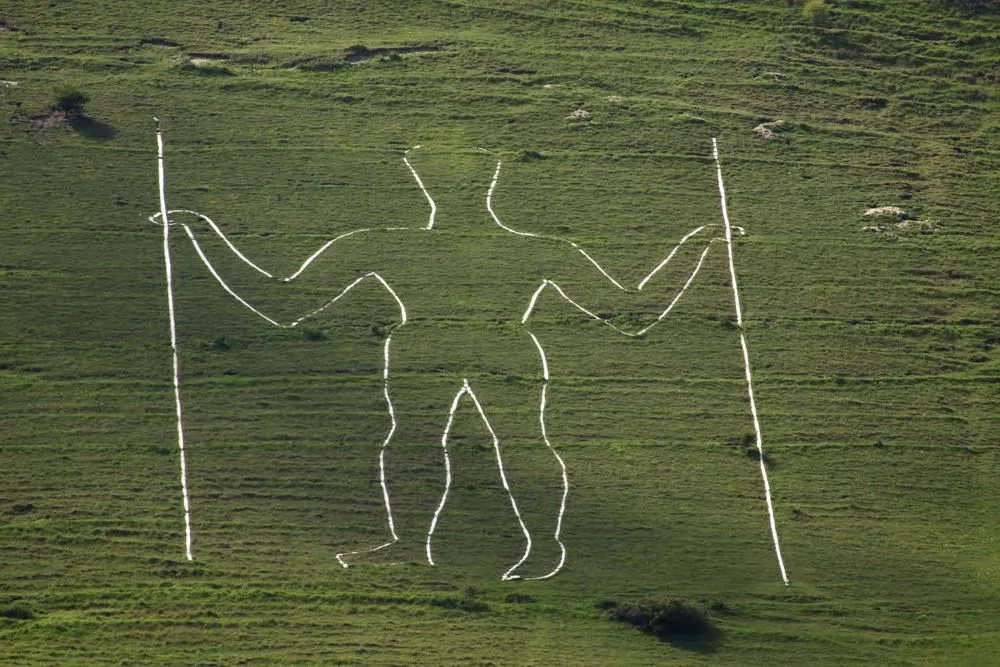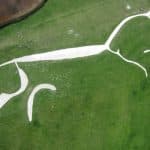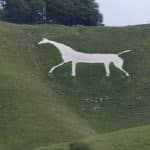Last Updated on 20/03/2023 by Alex Hamlyn
Table of Contents
Where is the Long Man of Wilmington?
What is the Long Man of Wilmington?
The Long Man of Wilmington is a large hill figure located in Wilmington, East Sussex, England. The figure is carved into the side of a hill exposing the chalk layer. The figure depicts a tall, slender man holding two staves.
The meaning of the staves is unknown. They may represent tools, possibly as agricultural implements such as ploughs or hoes. Some experts suggest that they may have had a religious or ceremonial significance, and that the figure may have been used in rituals or processions.
The true purpose and meaning of the figure and the staves is not known but it is possible the figure could have been used for religious or ceremonial purposes. The Long Man might also simply be a form of ancient artwork, or a representation of some political authority. He might be the representation of an ancient warrior, king or other significant person. It’s also possible he could be a fertility figure of some kind, but there is nothing notable about the image which relates to other known fertility art work.
It’s possible he represented something or someone important. It would certainly have taken a lot of work and effort to carve a figure this big in the side of a hill. However, it’s true purpose and origin is likely to remain a mystery.
How big is the Long Man of Wilmington?
The Long Man of Wilmington is approximately 230 feet (70 meters) tall and 217 feet (66 meters) wide. It is one of the largest hill figures in Britain and is clearly visible from a number of miles away on a clear day. The figure is carved into the side of a hill and its size and prominence make it an impressive and distinctive landmark in the area.
While it’s certainly big, the Long Man of Wilmington is not big enough to be visible from space with the naked eye. While it is a large figure carved into a hill, it’s not large enough to be visible from low Earth orbit, where most satellites and manned spacecraft operate. However, it is possible that the figure could be captured in high-resolution imagery taken by satellites, but it would likely be difficult to distinguish from the surrounding terrain.
Despite not being visible from above, one curious thing about the Long Man of Wilmington is that the figure was built on a hillside, which means it almost certainly would be seen from an angle by an ordinary person and this would give a distorted impression of the figure. However, when viewed from directly above, the distortion caused by the slope of the hill vanishes, and the Long Man appears to have normally proportioned features.
How old is the Long Man of Wilmington?
The Long Man was originally believed to date back to the late Iron Age or early Roman period, which would have made it one of the oldest surviving hill figures in Britain.
Since then, archaeological examinations which took place in 2003 have dated the figure more recently, and it is now believed to have been carved around the 16th or 17th century.
This means the Long Man of Wilmington is still an old site – perhaps 500 years old or more, but this new date places it in the Early Modern era of British history.
Today, the image is preserved by using lime mortar and breeze blocks painted white to mark out the original carving.
Where is the Long Man of Wilmington?
The Long Man of Wilmington is carved into the side of Windover Hill in (believe it or not) Wilmington, in East Sussex.
The carving is laid south to north, so he appears to be upside down on a north-oriented areal view.
The grid reference of the Long Man of Wilmington is 50.80999587134991, 0.1878817944692688.
You can see the Long Man of Wilmington on Google Maps here.
The figure is located on private land, but is visible from a nearby public footpath.
Is there a connection between the Long Man of Wilmington and the Wilmington Long Barrow?
The connection between the Long Man of Wilmington and the nearby Neolithic burial mound known as Wilmington Long Barrow is not well understood. The Long Barrow is a type of burial chamber that is common in the Neolithic period across Europe, especially in the British Isles. It is the close proximity of the Long Barrow which confused the dating of the Long Man for many years.
While they are located in close proximity to one another, it is not clear if there is any direct connection between the two sites.
Some experts believe that the Long Man may have been carved during the Bronze Age or Iron Age, while the Long Barrow dates back to the Neolithic period, making it unlikely that there is a direct connection between the two. It is also possible that the two sites were created by different groups of people at different times.
The area has been inhabited for thousands of years, so it is very possible that two independent groups separated by centuries could have made these two sites.
Is the Long Man of Wilmington unique?
Hill figures like the Long Man of Wilmington are rare but several others have been found in the United Kingdom. The Uffington White Horse, the Litlington White Horse and the Cerne Abbas Giant are the other most well-known figures. Other hill figures curved into the chalk landscape exist, but they are often far more recent creations and so don’t qualify as ancient sites.
It’s possible that the proximity of the two sites may have led to some sort of cultural or spiritual connection in the minds of ancient people, but there is no concrete evidence to support this theory.
Are there any other ancient sites nearby?
There are a number of ancient sites located near the Long Man of Wilmington, East Sussex, England. Some of the notable sites include:
- The Neolithic burial mound of Wilmington Long Barrow, located around 1.5 miles from the Long Man.
- The Roman Villa at Beauport Park which is located around 3 miles from Wilmington.
- The Roman road known as the “London to Lewes Way” passes nearby, and the Roman port of Noviomagus Reginorum (Chichester) is located around 12 miles to the west.
- The nearby ancient hill fort of Cissbury Ring which is located around 8 miles to the west.
- The ancient burial site of the Anglo-Saxon village of Beddingham which is located around 5 miles to the east.
All these ancient sites are open to the public and you can visit them and learn more about the rich history of the area.
Image credits
- Main image: The Long Man of Wilmington by Steve Daniels, CC BY-SA 2.0 https://creativecommons.org/licenses/by-sa/2.0, via Wikimedia Commons
References
- https://en.wikipedia.org/wiki/Long_Man_of_Wilmington
- https://www.discoveringbritain.org/activities/south-east-england/viewpoints/long-man.html
- https://sussexpast.co.uk/attraction/the-long-man-of-wilmington/
- https://www.atlasobscura.com/places/the-long-man-of-wilmington-wilmington-united-kingdom
- https://www.youtube.com/watch?v=g3tioWzRqsM



